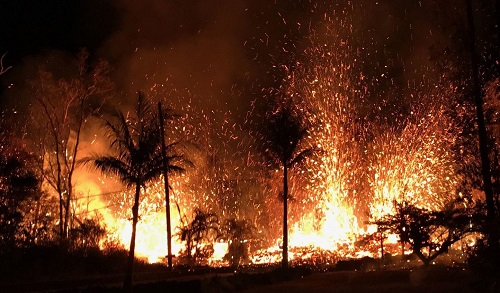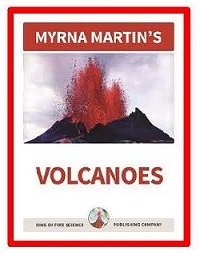Fun Volcano Facts
Facts about volcanoes
Stratovolcanoes, cinder cones, shield volcanoes and lava domes
Volcanoes dot the land around the Pacific Ocean. About 60%
of the individual volcanoes on Earth are stratovolcanoes. Cinder cones are
small cone shaped volcanoes with a crater at their summit. Shield volcanoes are
formed from magma in the upper mantle. Lava domes are small volcanoes that form
inside calderas after a major eruption. These are important volcano facts for kids to know.
Island of Hawaii volcanoes
Hawaiian Islands formed over a hot spot
The Hawaiian Islands volcanoes have formed over a persistent hot spot. The newest member of the Hawaiian Islands is Loihi. Loihi is a seamount off the coast of Kilauea. Someday it too will be a towering volcano like Kilauea and Mauna Loa.
Five giant shield volcanoes
The Island of Hawaii contains five volcanoes that formed when the Pacific Plate moved over the hot spot. Mauna Kea measured from the seafloor to its peak is the tallest mountain on Earth. Mauna Loa has historically been considered the largest volcano on Earth. Recently, Tamu Massif, discovered in the North Pacific Ocean has the largest footprint of any volcano on Earth.

Kilauea fissure eruption USGS
Tephra and Lava rocks
Tephra rocks
Tephra rocks are blown out of a volcano during a volcanic
eruption. Ash is commonly blown out of a volcano during a violent eruption. The
ash is pulverized rock. Lapilli are small pieces of lava that form during an
eruption when the lava breaks apart while airborne. Lava bombs are associated
with basalt eruptions that form an aerodynamic shape as it spins in the air
before landing on the ground.
Lava rocks
Lava rocks form when lava is fluid enough to flow out of the
vent of a volcano. Basalt lava is a fluid lava that can flow for hundreds of
miles in some areas before it cools into solid rock. Basalt also forms lava
tubes and lava caves as it flows away from the vent of a volcano. Skylights in
lava tubes allow basalt flowing through a lava tube to be viewed. Skylights
also allow scientists to take samples of the lava in the lava flow.
Andesite & rhyolite lavas
Andesite lava
Andesite lava contains a higher percentage of quartz than basalt. Dacite contains a higher percentage of quartz than andesite. This higher percentage of quarts creates lavas that can build up enough pressure for explosive eruptions by the volcanoes. Sometimes the force of the eruption will propel ash into the stratosphere where it can circle the Earth for years before it falls back to the ground.
Rhyolite lava
Rhyolite contains the highest percentage of quartz and is associated with supervolcano eruptions. Mount Tambora in Indonesia, Taupo in New Zealand and Yellowstone in the United States are three examples of supervolcanoes.

Volcanoes are fascinating because all the rocks that make up large and small volcanoes were molten rock. Chapter in this book includes information on major types of volcanoes, different types of eruptions, and volcanic rocks produced by the volcanoes . Myrna

Click for More Information and to Order
subduction zones
Where subduction zones form
Subduction zones are areas where an oceanic plate converges
with another tectonic plate. When a continental plate converges with an oceanic
plate the oceanic plate is forced beneath the continental plate. ‘
Stratovolcanoes form in subduction zones
About 60% of all the individual volcanoes on earth are stratovolcanoes.
These volcanoes form on the continental side of subduction zones.
Stratovolcanoes erupt primarily andesite and dacite that is more viscous than
basalt. Eruptions on these volcanoes typically alternate between explosive eruptions
of tephra and lava flows.
Basalt rocks
Basalt rocks on the seafloors
Basalt rocks that make up the seafloors are rich in iron and magnesium. Continental rocks contain primarily quartz and feldspar minerals that are lighter than the iron rich minerals in basalt. That is the reason that an ocean plate is always forced beneath a continental plate when they collide in a subduction zone.
Hawaiian Island Volcanoes
Hot spot volcanoes
The Hawaiian Islands volcanoes are a group of
islands that have formed over a hot spot beneath the Pacific Plate in the
middle of the Pacific Ocean. The Big Island of Hawaii contains five shield
volcanoes that formed over the hotspot as the Pacific Plate drifts northward.
Basalt from the upper mantle feeds the volcanoes
Each of the islands was created out of basalt that collected
in a magma chambers beneath the volcanoes. The hot spot is stationary, but the
Pacific Plate is in constant motion. The Pacific Plate is moving northward
where it subducts beneath the North American Plate. Scientists have tracked the
movement of the plate by plotting the location of seamounts on the seafloor.
Why chains of volcanoes become dormant
Volcanoes in chains of islands that form over a hotspot become dormant when the magma chambers of individual volcanoes
no longer were above the hot spot. When the plate moved past the hotspot molten rock stopped filling the magma chambers and the eruptions ceased.
Loihi seamount
The newest member of the Hawaiian volcanoes
The newest member of the Hawaiian volcanoes is Loihi. Loihi is a seamount off the coast of Kilauea that is growing. Scientists at one
time thought it was an extinct volcano until it started erupting in the recent past. Sometime in
the distant future Loihi Volcano will become an island when its summit rises
above the surface of the ocean.
KIDS FUN Science Bookstore
Check out Myrna Martin's award winning textbooks, e-books, videos and rock sets. The Kids Fun Science Bookstore covers a wide range of earth science topics. Click here to browse.










